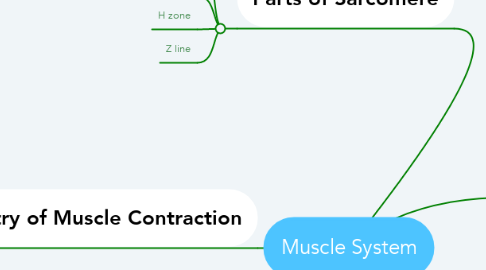
1. Parts of Sarcomere
1.1. A band
1.2. I band
1.3. H zone
1.4. Z line
2. Chemistry of Muscle Contraction
2.1. ATP
2.1.1. The only energy source that can be used directly to power muscle activity.
2.2. Mitochondria
2.3. Aerobic Cellular Respiration
2.4. Anarobic Cellular Respiration
2.5. Creatine Phosphate
2.6. Muscle Fatigue
2.7. Build-up of Lactic Acid
3. Exercise
3.1. Aerobic
3.1.1. Results in more stronger, flexible muscles, with greater resistance to fatigue.
3.1.1.1. Jogging, biking, swimming
3.2. Isometric
3.2.1. Results in stronger, and larger muscles.
3.2.1.1. Weights, etc. (requires little to no equipment)
4. Types of Muscle
4.1. Cardiac
4.1.1. Characteristics
4.1.1.1. Striated
4.1.1.2. Involuntary
4.1.1.3. Intercalated Discs
4.1.2. Location
4.1.2.1. Heart
4.1.3. Function
4.1.3.1. Pumps blood through circulatory system
4.2. Smooth
4.2.1. Characteristics
4.2.1.1. Involuntary
4.2.1.2. Visceral
4.2.1.3. Nonstriated
4.2.2. Location
4.2.2.1. In the walls of hollow visceral organs
4.2.3. Function
4.2.3.1. It propels substances along a tract, or pathway, within the body.
4.3. Skeletal
4.3.1. Characteristics
4.3.1.1. Striated
4.3.1.2. Voluntary
4.3.2. Location
4.3.2.1. Attached to bones or sometimes, skin
4.3.3. Function
4.3.3.1. Listen and respond to impulses, reflexes, and, nerves.
5. Muscle Anatomy
5.1. Fibers
5.2. Myofibrils
5.2.1. Sarcomeres
5.2.1.1. Allows muscles to
5.2.1.1.1. Contract
5.2.1.1.2. Relax
5.2.1.2. Myofilaments
5.2.1.2.1. Protein
